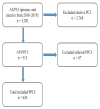Influence of Organisational-Level Factors on Delayed Door-to-Balloon Time among Patients with ST-Elevation Myocardial Infarction
- PMID: 38828238
- PMCID: PMC11139363
- DOI: 10.18295/squmj.12.2023.089
Influence of Organisational-Level Factors on Delayed Door-to-Balloon Time among Patients with ST-Elevation Myocardial Infarction
Abstract
Objectives: This study aimed to estimate the door-to-balloon (DTB) time and determine the organisational-level factors that influence delayed DTB times among patients with ST-elevation myocardial infarction in Oman.
Methods: A cross-sectional retrospective study was conducted on all patients who presented to the emergency department at Sultan Qaboos University Hospital and Royal Hospital, Muscat, Oman, and underwent primary percutaneous coronary interventions during 2018-2019.
Results: The sample included 426 patients and the median DTB time was 142 minutes. The result of the bivariate logistic regression showed that patients who presented to the emergency department with atypical symptoms were 3 times more likely to have a delayed DTB time, when compared to patients who presented with typical symptoms (odds ratio [OR] = 3.003, 95% confidence interval [CI]: 1.409-6.400; P = 0.004). In addition, patients who presented during off-hours were 2 times more likely to have a delayed DTB time, when compared to patients who presented during regular working hours (OR = 2.291, 95% CI: 1.284-4.087; P = 0.005).
Conclusion: To meet the DTB time recommendation, it is important to ensure adequate staffing during both regular and irregular working hours. Results from this study can be used as a baseline for future studies and inform strategies for improving the quality of care.
Keywords: Acute Myocardial Infarction; Coronary Balloon Angioplasty; Emergency Care Systems; Oman; Patient Care Management; Staffing and Scheduling.
© Copyright 2024, Sultan Qaboos University Medical Journal, All Rights Reserved.
Conflict of interest statement
CONFLICTS OF INTEREST: The authors declare no conflict of interest.
Figures
Similar articles
-
Use of emergency medical services expedites in-hospital care processes in patients presenting with ST-segment elevation myocardial infarction undergoing primary percutaneous coronary intervention.Cardiovasc Revasc Med. 2014 Jun;15(4):219-25. doi: 10.1016/j.carrev.2014.03.011. Epub 2014 Mar 26. Cardiovasc Revasc Med. 2014. PMID: 24952684
-
Door-to-balloon time and factors associated with delayed door-to-balloon time in ST-segment elevation myocardial infarction at Thailand's largest tertiary referral centre.J Eval Clin Pract. 2019 Jun;25(3):434-440. doi: 10.1111/jep.13061. Epub 2018 Nov 12. J Eval Clin Pract. 2019. PMID: 30417495
-
A method for improving arrival-to-electrocardiogram time in emergency department chest pain patients and the effect on door-to-balloon time for ST-segment elevation myocardial infarction.Acad Emerg Med. 2009 Oct;16(10):921-7. doi: 10.1111/j.1553-2712.2009.00493.x. Epub 2009 Sep 15. Acad Emerg Med. 2009. PMID: 19754862
-
Effect on door-to-balloon time of immediate transradial percutaneous coronary intervention on culprit lesion in ST-elevation myocardial infarction compared to diagnostic angiography followed by primary percutaneous coronary intervention.Am J Cardiol. 2013 Mar 15;111(6):836-40. doi: 10.1016/j.amjcard.2012.11.059. Epub 2013 Jan 11. Am J Cardiol. 2013. PMID: 23313341
-
Effect of onset-to-door time and door-to-balloon time on mortality in patients undergoing percutaneous coronary interventions for st-segment elevation myocardial infarction.Am J Cardiol. 2010 Jul 15;106(2):143-7. doi: 10.1016/j.amjcard.2010.02.029. Epub 2010 Jun 10. Am J Cardiol. 2010. PMID: 20598994
References
-
- Park J, Choi KH, Lee JM, Kim HK, Hwang D, Rhee TM, et al. Prognostic implications of door-to-balloon time and onset-to-door time on mortality in patients with ST-segment–elevation myocardial infarction treated with primary percutaneous coronary intervention. J Am Heart Assoc. 2019;8:e012188. doi: 10.1161/JAHA.119.012188. - DOI - PMC - PubMed
-
- McCance KL, Huether SE. Pathophysiology: The Biologic Basis for Disease in Adults and Children. 8th ed. Maryland Heights; Missouri, USA: Mosby: 2018.
-
- Jneid H, Addison D, Bhatt DL, Fonarow GC, Gokak S, Grady KL, et al. 2017 AHA/ACC clinical performance and quality measures for adults with ST-elevation and non-ST-elevation myocardial infarction: A report of the American College of Cardiology/American Heart Association task force on performance measures. Circ Cardiovasc Qual Outcomes. 2017;10:e000032. doi: 10.1161/HCQ.0000000000000032. - DOI - PubMed
MeSH terms
LinkOut - more resources
Full Text Sources

